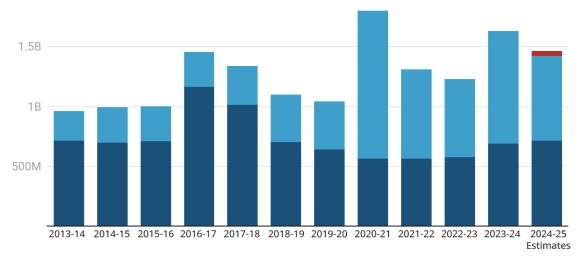A report by the Maytree Foundation shows that spending on affordable housing and homelessness is about where it was a decade ago. And current spending is only half of what’s needed to end chronic homelessness, which is a small part of the crisis of unaffordable and increasingly precarious housing.

The chart at right shows that except for the COVID-19 year, provincial government spending on homeless remained below 2016-17 until last year.
The chart also shows that Ontario housing and homelessness dollars are increasingly spent on shelters and other emergency measures (the turquoise bars), not on the affordable housing needed for people to exit homelessness (the dark blue bars). Read the report here: https://maytree.com/publications/provincial-spending-on-housing-and-homelessness-in-ontario/
A related report, done for Ontario municipal organizations, calculated that:
81,515 Ontarians were known to be homeless in 2024. That’s a up 25% in two years. Chronic homelessness—being homeless for more than six months—has tripled in a decade and now makes up half of that total. That means that not only are more people becoming homeless but that they stay homeless longer.
The municipal report estimated it would cost an extra $11 billion in a decade, on top of current spending, to end chronic homelessness. That’s a minimum investment, since it would still leave people without homes. And it would leave more than 800,000 households in Ontario struggling with the constant stress of paying too much for their housing and thus stretched for other necessities, or living in an overcrowded home or one that needs major repairs. As indicated in the previous item, the investment we need is enough to at least double the number of non-profit affordable homes in a decade, from 350,000 to 700,000, and then keep making those investments, year after year.
You can read the report at https://www.amo.on.ca/policy/health-emergency-and-social-services/amo-launches-groundbreaking-homelessness-study-ontario